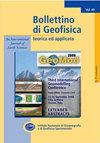A least-squares collocation procedure to merge local geoids with the aid of satellite-only gravity models: the Italian/Swiss geoids case study
IF 0.7
4区 地球科学
Q4 GEOCHEMISTRY & GEOPHYSICS
引用次数: 5
Abstract
Neighbouring countries often have national geoids that do not fit to each other, typically showing a discontinuity along the border. Among other effects, this discontinuity is mainly due to the different height datum, producing biased local geoids which can also have different accuracies and spatial resolutions. In some applications, for instance in case of international civil engineering works, a merging between two neighbouring geoids can be necessary. Obviously this procedure cannot be done by simply averaging overlapping areas completely disregarding biases. This paper deals with this problem in connection to the availability of data from satellite gravity missions. In contrast to terrestrial gravity anomalies, gravity and geoid models derived from satellite gravity missions, and in particular from GRACE and GOCE, do not suffer from those inconsistencies. These models in fact are not affected by local biases (local reference systems) since they do not make use of any ground gravity data or levelling. Basically this means that these models can provide the long wavelengths of the resulting merged geoid, in this way removing national biases or other systematic effects. On the other hand, the short wavelengths will directly come from a combination of the available local geoids. This article proposes a least-squares collocation procedure to merge local geoids with the help of these satellite-only gravity models. Even if the correct approach to produce a unique unbiased geoid is to start from the original terrestrial gravity data together with satellite data, the presented procedure can be helpful to merge already available local models. After a review of the mathematical formulation of the problem, the paper illustrates the case of the merging of the Italian and Swiss geoids, more specifically the Swiss CHGeo2004 and the Italian ITALGEO2005 pure gravimetric local models. A constant bias with respect to the GOCE reference (WGS84 ellipsoid) of about 100 cm for the Italian local geoid and of about 80 cm for the Swiss one have been estimated and removed. After that a unique geoid with an accuracy of few centimetres has been computed by collocation. A first application of this new geoid, named GISgeo2012 (GOCE, Italian and Swiss geoid) will be within the interreg project Helidem (HELvetia-Italy Digital Elevation Model) to create a new unified digital elevation model in orthometric height.借助卫星重力模型合并局部大地水准面的最小二乘配置程序:意大利/瑞士大地水准面案例研究
邻国的大地水准面常常彼此不一致,通常沿边界显示出不连续性。在其他影响中,这种不连续性主要是由于不同的高度基准,产生偏置的局部大地水准面,也可能具有不同的精度和空间分辨率。在某些应用中,例如在国际土木工程的情况下,两个相邻的大地水准面之间的合并可能是必要的。显然,这个过程不能通过简单地对重叠区域进行平均而完全忽略偏差来完成。本文结合卫星重力任务数据的可获得性来讨论这一问题。与地面重力异常相比,卫星重力任务,特别是GRACE和GOCE的重力和大地水准面模型没有这些不一致之处。这些模型实际上不受当地偏差(当地参考系统)的影响,因为它们不使用任何地面重力数据或找平。基本上,这意味着这些模型可以提供最终合并的大地水准面长波,以这种方式消除国家偏差或其他系统影响。另一方面,短波将直接来自可用的局部大地水准面组合。本文提出了一种利用卫星重力模型合并局部大地水准面的最小二乘配置方法。即使产生唯一无偏大地水准面的正确方法是从原始的地球重力数据和卫星数据一起开始,所提出的程序也有助于合并已有的局部模型。在回顾了该问题的数学公式之后,本文举例说明了意大利和瑞士大地水准面合并的情况,更具体地说,是瑞士CHGeo2004和意大利ITALGEO2005纯重力局部模型。意大利当地大地水准面与GOCE参考(WGS84椭球)的恒定偏差约为100厘米,瑞士当地大地水准面约为80厘米,已经估计并消除。在此基础上,通过配位计算得到了精度为几厘米的唯一大地水准面。这种新的大地水准面被命名为GISgeo2012 (GOCE,意大利和瑞士大地水准面),将在Helidem (helvetia -意大利数字高程模型)项目中首次应用,以创建一个新的统一的数字高程模型。
本文章由计算机程序翻译,如有差异,请以英文原文为准。
求助全文
约1分钟内获得全文
求助全文
来源期刊

Bollettino Di Geofisica Teorica Ed Applicata
地学-地球化学与地球物理
自引率
0.00%
发文量
0
审稿时长
>12 weeks
期刊介绍:
The "Bollettino di Geofisica Teorica ed Applicata" is an international open access journal dedicated to the publication of original papers dealing with Deep Earth Geophysics, Near Surface Geophysics, Exploration Geophysics, Borehole Geophysics, Geodynamics and Seismotectonics, Seismology, Engineering Seismology, Geophysical Modelling, Geodesy, Remote Sensing, Seismic and Geodetic Networks, Oceanography, and their application in the fields of Energy, Natural Resources, Environment and Climate, Policies and Regulations, Risk and Security, Technological Development.
 求助内容:
求助内容: 应助结果提醒方式:
应助结果提醒方式:


